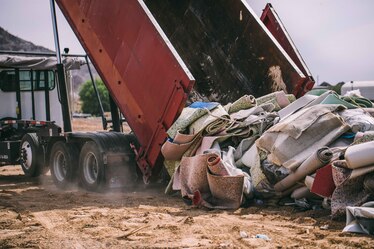The process that's saving Arizona's carpets from landfill

PHOENIX, DESERT CITY
Phoenix, Arizona, is a city on the frontlines of climate change. America’s fifth largest metropolis has the highest average annual temperatures of any US city and serious issues with its water supply, yet continues to grow at pace, taking its high consumption urban sprawl ever deeper into the surrounding desert. Andrew Ross’ 2011 book, Bird on Fire: Lessons from the World’s Least Sustainable City, famously charted Phoenix’s many issues, but the city has begun to flip the script and find ways to lessen its environmental impact. One prime example of this is a new upcycling initiative that takes a pressing waste problem and turns it into a valuable resource.
SOFT-PILE TRASH
Old carpets are dumped at a commercial landfill in Phoenix. More than five billion pounds (two billion kilos) of discarded carpet ends up in landfill every year in the US alone. Because most carpets are made from plastics sourced from the petrochemical industry, they can take centuries to breakdown. As these carpet fibers break breakdown in landfill, they release methane, one of the most potent greenhouse gases, into our atmosphere. Meanwhile, toxic chemicals from the carpet can leach into the surrounding environment, especially in landfills that aren’t properly managed.
A HIDDEN THREAT
Piles of old carpet at a landfill in Phoenix, Arizona. While the environmental impact of single-use plastics like straws, coffee cup lids, and shopping bags has been hitting headlines for years, carpet waste remains an out of sight, out of mind issue. Carpet manufacturers have long relied on linear supply chains to produce products that are made with long term durability in mind, not recyclability - even though the average life of a carpet is just eight to 10 years. Despite this, the elements that make up a synthetic carpet can all be reused across a range of industries.
RECLAIMING OLD CARPET
Plant worker Gregory Jimenez transfers synthetic carpet at the Planet Recycling facility in Phoenix, Arizona. Planet Recycling stores and processes old carpet, and also sells new and recycled carpet. Because carpet is a compound product made to last a long time, it’s not easy to break down. Carpet backing comprises of polypropylene for durability, and calcium carbonate, which adds bulk and heft at a low cost. Some carpet pile is made from polyester but most (around 75%) is made from nylon. In the past, separating out these chemical compounds has proven both difficult and expensive.
COMPACTING CARPET
Rick Sandoval, operates a hydraulic compressor used to compact the old carpet into bales that can be easily stored and transported. The carpet is first sorted using a sensor, which detects whether the pile is made of polyester or nylon. Polyester carpet is generally cheaper to produce and is sometimes made using recycled plastic bottles. However, the resulting carpet can only be used once - after that it still ends up in landfill. Planet Recycling is already dealing with more carpet than the facility can handle, but a new facility in Phoenix is helping cope with the backlog of nylon carpets.
A MAZE OF CARPET BALES
Plant Manager Juan Carlos Anota oversees a facility that breaks down discarded carpets into their component parts. Bales of carpets are stored in the 35,000 square foot warehouse before specialized machinery processes up to 16,000 tons of them every year. Owned by Italian company Aquafil, the facility recycles nylon retrieved from the rugs into a pristine yarn called ECONYL. Aquafil has been in the Nylon game for many years, and is making sustainability central to its operations with a global supply chain that incorporates different plastic waste streams.
CARPET AS COMPOSITE
Aquafil have developed a dry and wet process that separates the carpet into its component parts. First, workers place the carpet by hand onto a conveyor that feeds into a shredder. This reduces the carpet to small fragments, separating the calcium carbonate from the two plastic elements. Surprisingly, calcium carbonate, a chemical compound that is prevalent everywhere in nature from chalk to marble to shellfish, constitutes as much as 45% of a carpet’s total volume.
21st CENTURY ALCHEMY
Aquafil uses a range of techniques to separate the three component parts of the carpet into separate streams, from ripping and shredding in the dry phase to washing and scrubbing in the wet phase. The smaller the fragments of carpet get, the more calcium carbonate is removed. In the wet process, the polypropylene is separated from the nylon and the latter is melted down to create long spaghetti like strands of plastic that are then diced into pellets. Aquafil sells the calcium carbonate and polypropylene to other businesses, but the nylon, which is about 97% pure, is shipped to Europe where it is further purified to make ECONYL yarn.
RECOVERED RAW MATERIALS
The polypropylene fluff is refined and used in injection molding to make plastic containers and packaging, while the calcium carbonate emerges as ash that is used widely in the construction industry. Aquafil now works with a wide range of partners in the fashion and homeware industries, including Prada, who through the Prada Re-Nylon project, are supporting upcycling projects worldwide and incorporating ECONYL yarn in many of their iconic pieces.